A work plan is a crucial element in ensuring the success of a project. It lays out all the activities, tasks, and deadlines in a clear and organized manner, making it easier for teams to manage their workloads effectively. The plan specifies who is responsible for each task and helps in monitoring the progress of the project to avoid any potential delays.
This document is usually required when submitting a proposal for a project and acts as a guide throughout the entire project lifecycle. Work plans provide a comprehensive overview of the project, making it easier for team members, stakeholders, and project managers to stay on track and achieve their goals.
Table of Contents
Work Plan Templates
Work plan templates are comprehensive documents that outline the steps, tasks, and timeline required to successfully complete a project or achieve specific objectives within an organization. These templates provide a structured framework for planning and executing work, ensuring that all necessary aspects are considered and accounted for.
A work plan template typically includes various sections that guide project managers and team members in organizing and coordinating their efforts. The template begins with a clear statement of the project’s objectives, goals, and deliverables. This section provides a shared understanding of what needs to be accomplished and serves as a reference point throughout the project’s duration.
The template also includes a detailed breakdown of tasks and activities required to achieve the project’s objectives. Each task is assigned a responsible party or team member, and dependencies between tasks are clearly identified. This helps ensure smooth coordination and efficient utilization of resources. Additionally, milestones and deadlines are established, enabling progress tracking and timely adjustments if necessary.
Types of Work Plan

There are several types of work plans, including:
Project Work Plan: This type of plan outlines the activities and tasks required to complete a project, including timelines, budget, and resources.
Operational Work Plan: An operational work plan is used to define the daily, weekly, or monthly activities required to meet an organization’s goals.
Strategic Work Plan: A strategic work plan outlines an organization’s long-term goals and objectives, and the steps required to achieve them.
Personal Work Plan: A personal work plan is a self-created plan that outlines an individual’s goals, tasks, and deadlines, often for personal or professional development.
Team Work Plan: A team work plan outlines the responsibilities of team members and the tasks they need to complete to achieve a common goal.
Departmental Work Plan: A departmental work plan outlines the goals and objectives of a specific department within an organization, and the steps required to achieve them.
Emergency Work Plan: An emergency work plan outlines the procedures and processes to be followed in case of an emergency or disaster.
Construction Work Plan: A construction work plan outlines the tasks and timelines involved in a construction project, including materials, budget, and safety considerations.
Maintenance Work Plan: A maintenance work plan outlines the steps required to keep equipment, facilities, and infrastructure in good working condition.
Sales Work Plan: A sales work plan outlines the steps and strategies needed to achieve sales goals, including target markets, customer segmentation, and sales processes.
Marketing Work Plan: A marketing work plan outlines the steps required to achieve marketing goals, including market research, advertising, and promotions.
Event Work Plan: An event work plan outlines the tasks and deadlines involved in planning and executing an event, including venue selection, catering, and event promotion.
Resource Work Plan: A resource work plan outlines the allocation of resources, including personnel, equipment, and materials, to support a project or organization.
Budget Work Plan: A budget work plan outlines the estimated costs and expenses of a project or organization, including revenue projections and cost-saving measures.
Environmental Work Plan: An environmental work plan outlines the steps required to mitigate the impact of a project on the environment, including waste management, conservation, and sustainability initiatives.
Health and Safety Work Plan: A health and safety work plan outlines the measures and procedures to ensure the health and safety of employees, contractors, and the public during a project.
Quality Work Plan: A quality work plan outlines the steps required to ensure the quality of a project or product, including inspection, testing, and quality control processes.
Human Resources Work Plan: A human resources work plan outlines the steps required to recruit, train, and manage personnel, including compensation, benefits, and training programs.
Each type of work plan is tailored to the specific needs and goals of the project or organization, and it is important to choose the right type of plan to ensure success.
Advantages of Making and Using Project Work Plan Templates
There are several advantages to making and using a project work plan, including:
Improved Organization: A project work plan helps to organize all the activities, tasks, and deadlines involved in a project, making it easier to manage and monitor progress.
Better Resource Management: A project work plan outlines the resources needed for a project, including personnel, equipment, and materials, making it easier to manage and allocate resources effectively.
Increased Productivity: By clearly outlining the tasks and deadlines involved in a project, a work plan can help increase productivity and reduce the time required to complete the project.
Better Communication: A project work plan serves as a clear and concise guide for all stakeholders, including team members, managers, and stakeholders, improving communication and collaboration.
Reduced Risk: A project work plan helps to identify and mitigate potential risks and obstacles, reducing the likelihood of delays or unexpected costs.
Better Budget Management: A project work plan outlines the estimated costs and expenses of a project, making it easier to manage the budget and avoid overspending.
Increased Accountability: A project work plan assigns responsibilities to team members, increasing accountability and ensuring everyone is aware of their role in the project.
Better Decision-Making: A project work plan provides a comprehensive overview of the project, making it easier for project managers to make informed decisions and resolve any issues that may arise.
In summary, a well-designed project work plan can provide numerous benefits to a project or organization, helping to ensure its success.
Elements of a Work Plan
A work plan typically includes the following elements:
Objectives and Goals: A clear statement of the objectives and goals of the project or organization, including specific targets and milestones.
Scope of Work: A description of the scope of the project, including the tasks and activities involved, and any constraints or limitations.
Schedule: A detailed timeline of the project, including start and end dates, and deadlines for each task and activity.
Budget: An estimate of the costs involved in the project, including revenue projections and cost-saving measures.
Resources: A list of the personnel, equipment, and materials needed to complete the project, including allocation and scheduling.
Risk Management: An assessment of potential risks and obstacles, including strategies to mitigate or avoid them.
Performance Metrics: A set of metrics to measure the success of the project, including progress against objectives and goals.
Communication Plan: A plan for communication between team members, stakeholders, and project managers, including regular updates and reporting.
Contingency Plan: A plan for addressing unexpected events or circumstances, including backup plans and alternate solutions.
Review and Evaluation: A plan for reviewing and evaluating the success of the project, including lessons learned and opportunities for improvement.
These components provide a comprehensive framework for the project or organization, helping to ensure its success by providing a clear roadmap and guidance for action.
How To Create a Work Plan
Creating a work plan can be a complex and time-consuming process, but by following a structured approach, you can ensure that your plan is well-designed and effective. Here is a step-by-step guide to creating a work plan:
Step 1: Define Objectives and Goals
The first step in creating a work plan is to define the objectives and goals of the project or organization. This should include specific targets and milestones, as well as a clear understanding of what you want to achieve. It is important to be as specific as possible, and to ensure that your goals are realistic, achievable, and measurable.
Step 2: Conduct a Needs Assessment
The next step is to conduct a needs assessment to identify the tasks and activities required to achieve your goals. This should include an analysis of the resources needed, including personnel, equipment, and materials, as well as any constraints or limitations that may impact the project. The needs assessment should also consider any potential risks or obstacles, and strategies to mitigate them.
Step 3: Develop a Schedule
Based on the results of your needs assessment, you can develop a detailed schedule of the project. This should include start and end dates, and deadlines for each task and activity, as well as a timeline for completion. The schedule should also take into account any contingencies or backup plans, in case of unexpected events or circumstances.
Step 4: Establish a Budget
The next step is to establish a budget for the project. This should include an estimate of the costs involved, including revenue projections and cost-saving measures. The budget should be based on the schedule and the needs assessment, and should take into account any potential risks or obstacles that may impact the project.
Step 5: Allocate Resources
Once you have developed a budget, you can allocate resources to support the project. This includes personnel, equipment, and materials, and should be based on the schedule and the needs assessment. It is important to ensure that the resources are allocated effectively and efficiently, and to consider any constraints or limitations that may impact the project.
Step 6: Develop a Risk Management Plan
A risk management plan is an essential component of a work plan, and should include an assessment of potential risks and obstacles, as well as strategies to mitigate or avoid them. This should be based on the needs assessment and the schedule, and should take into account any potential risks or obstacles that may impact the project.
Step 7: Develop Performance Metrics
A set of performance metrics is an important tool to measure the success of the project, and should be included in your work plan. This should include metrics to measure progress against objectives and goals, as well as measures of efficiency and effectiveness. The performance metrics should be based on the schedule and the needs assessment, and should take into account any potential risks or obstacles that may impact the project.
Step 8: Develop a Communication Plan
A communication plan is essential to ensure effective communication between team members, stakeholders, and project managers. This should include regular updates and reporting, as well as a clear understanding of the roles and responsibilities of each team member. The communication plan should be based on the schedule and the needs assessment, and should take into account any potential risks or obstacles that may impact the project.
Step 9: Develop a Contingency Plan
A contingency plan is an essential component of a work plan, and should include a plan for addressing unexpected events or circumstances. This should include backup plans and alternate solutions, and should be based on the schedule and the needs assessment. The contingency plan should take into account any potential risks or obstacles that may impact the project, and should be reviewed and updated regularly.
Step 10: Review and Evaluation
Finally, it is important to review and evaluate the work plan regularly to ensure that it is on track and effective. This should include regular assessments of progress against objectives and goals, as well as regular reviews of the budget and schedule. It is also important to evaluate the performance of the project and make any necessary adjustments to the work plan, based on the results of these evaluations.
It is also important to review and evaluate the risk management plan, communication plan, and contingency plan, to ensure that they are effective and up-to-date. This may involve making changes to these plans based on the results of regular assessments and evaluations.
In summary, creating a work plan is a critical step in ensuring the success of a project or organization. By following a structured approach and regularly reviewing and evaluating the plan, you can ensure that your project is well-designed, well-executed, and effective.
FAQs
What is the difference between a work plan and a project plan?
A work plan is a detailed plan outlining the tasks, activities, and resources required to achieve specific goals or objectives. A project plan is a more comprehensive plan that includes the work plan as well as other elements, such as the project scope, timeline, budget, resources, and risk management plan. A project plan provides a more comprehensive view of the project and is often used to secure funding and support from stakeholders.
How often should a work plan be reviewed and updated?
A work plan should be reviewed and updated regularly, typically on a monthly or quarterly basis. The frequency of review and update may vary depending on the size and complexity of the project.
How does a work plan relate to the overall project management process?
A work plan is an important part of the overall project management process. It provides a roadmap for the project, helps to ensure that all goals and objectives are met, and provides a framework for monitoring and evaluating progress. The work plan is used in conjunction with other project management tools and processes, such as project scheduling, risk management, and performance evaluation, to ensure the success of the project.
How do you evaluate a work plan?
To evaluate a work plan, you should:
- Regularly review progress against the project goals and objectives
- Assess the effectiveness of the budget and schedule
- Evaluate the performance of the project and make any necessary adjustments to the work plan
- Review the risk management plan, communication plan, and
contingency plan to ensure that they are effective and up-to-date.



















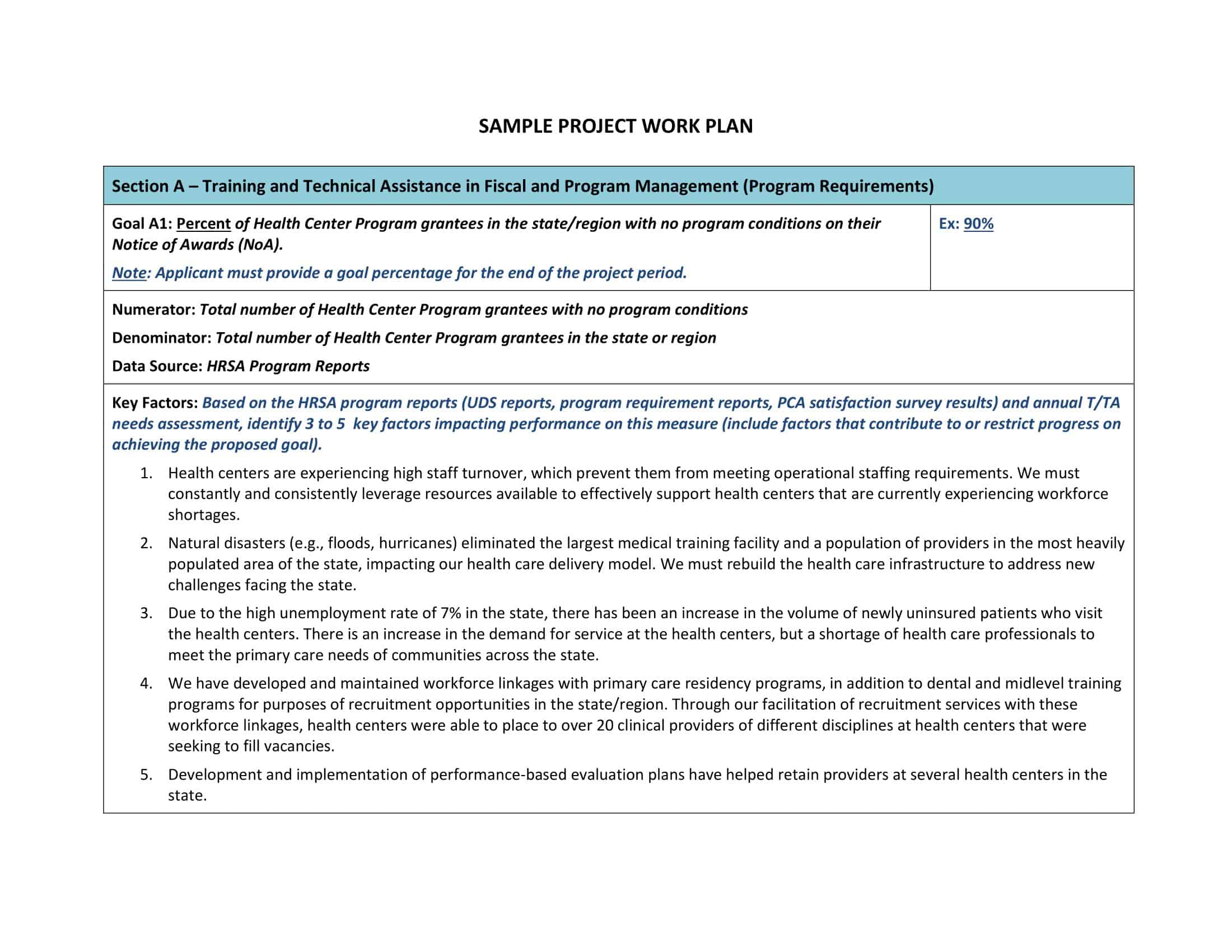










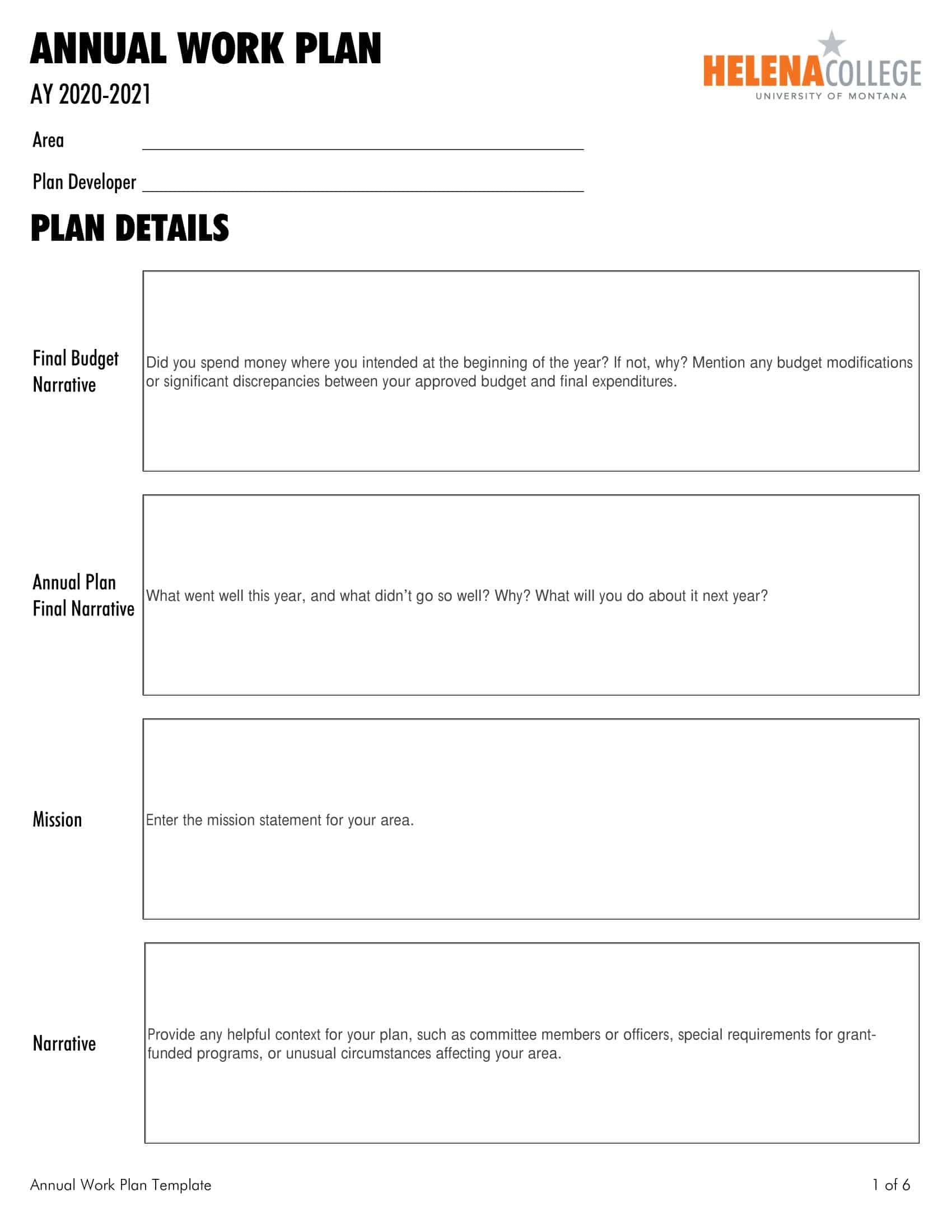

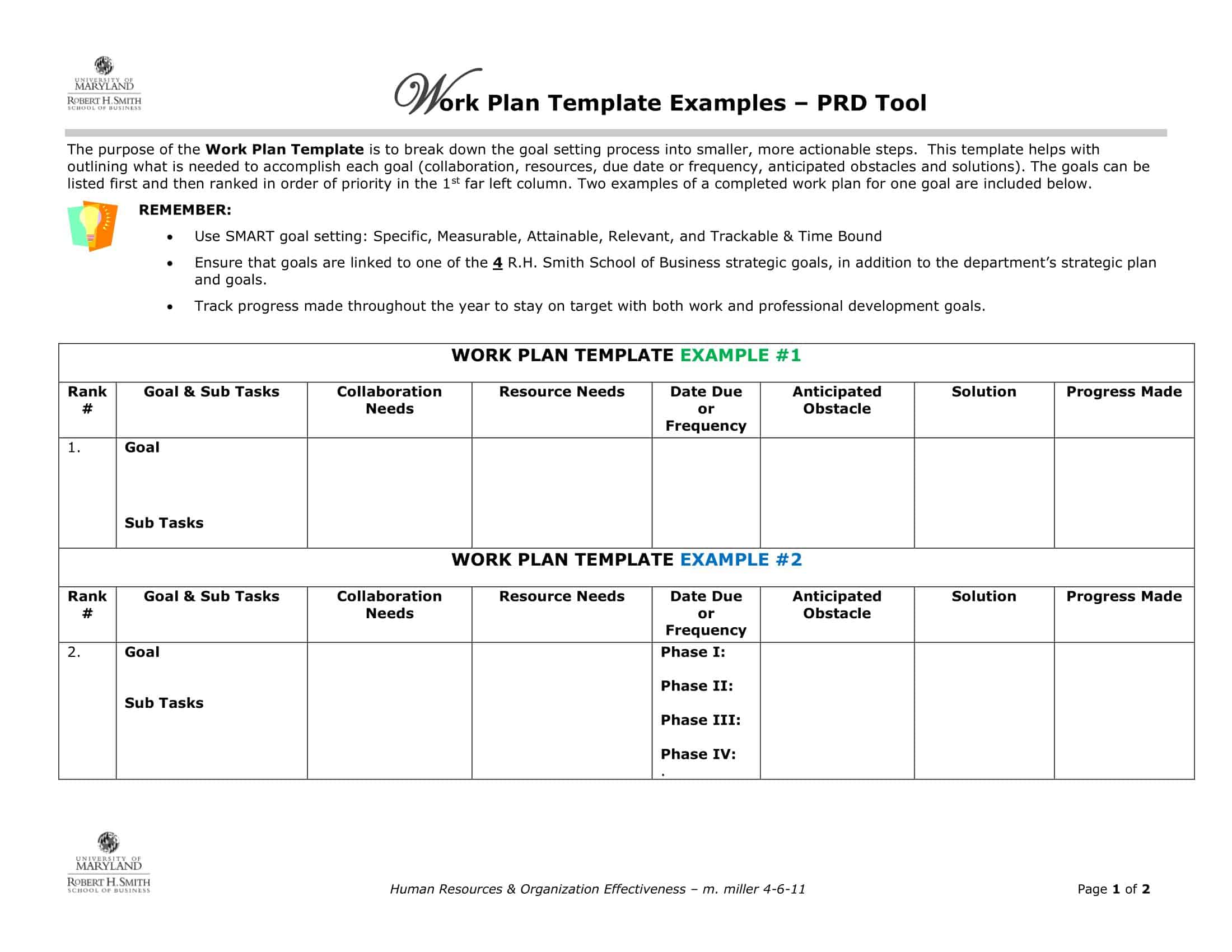

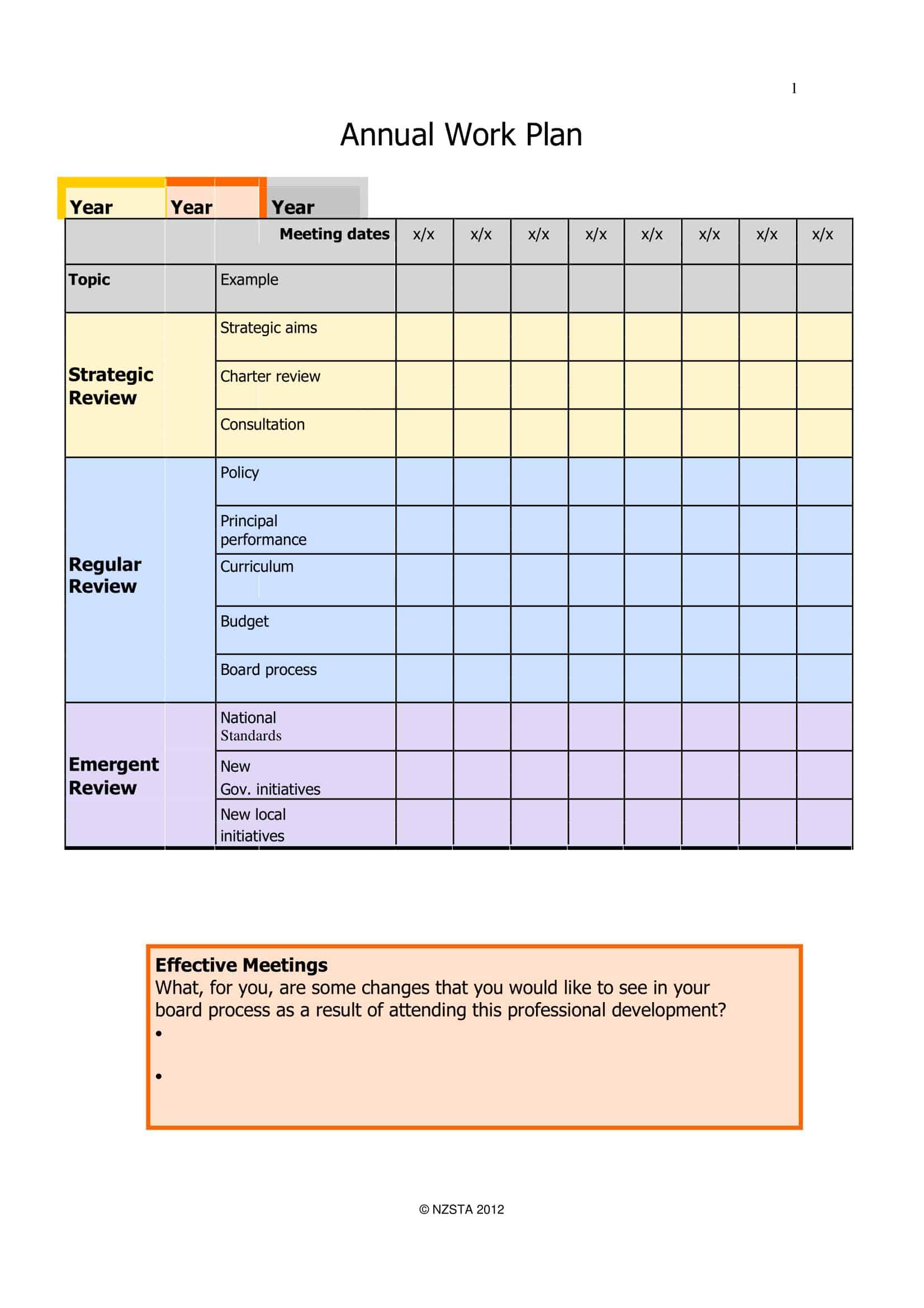






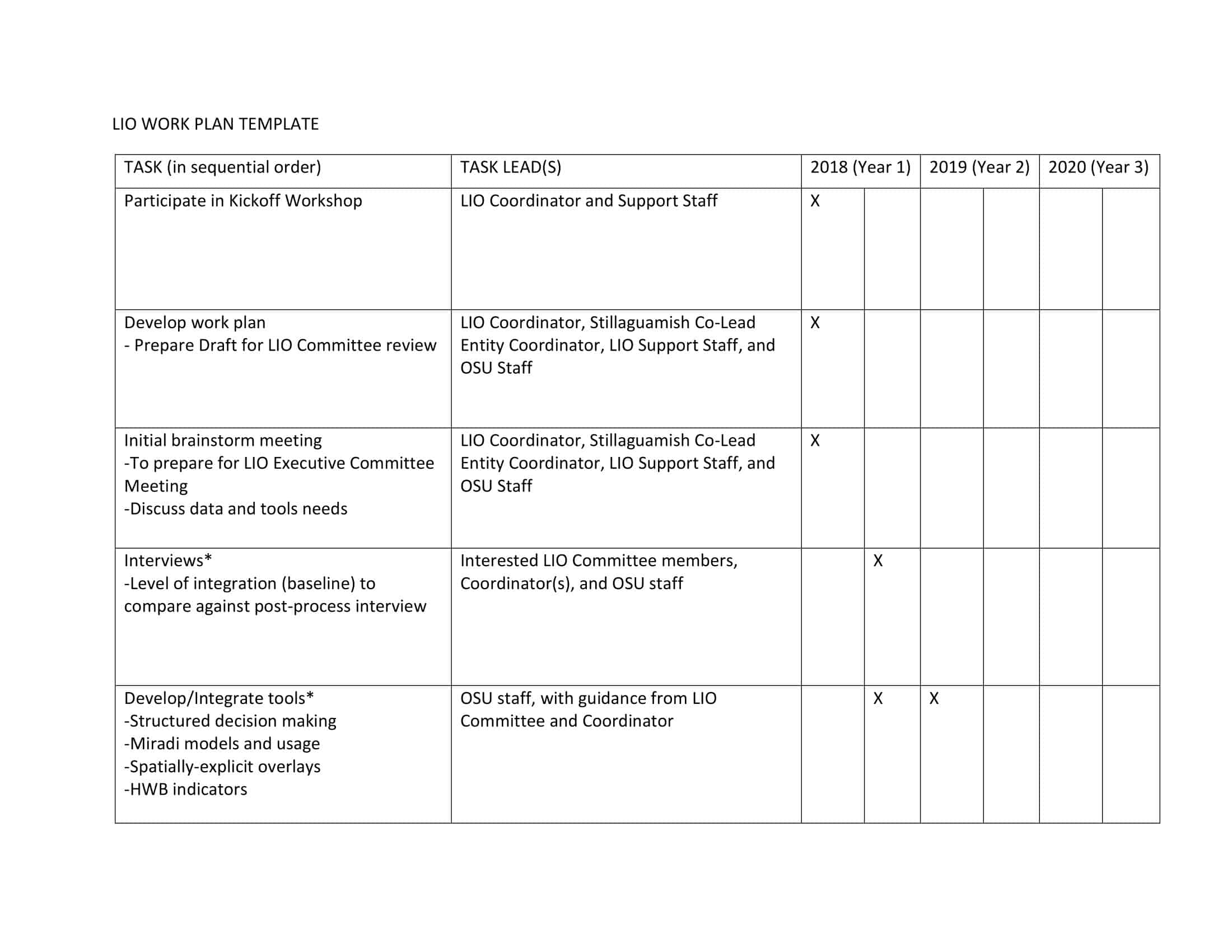










![Free Printable Roommate Agreement Templates [Word, PDF] 1 Roommate Agreement](https://www.typecalendar.com/wp-content/uploads/2023/06/Roommate-Agreement-150x150.jpg)
![Free Printable Credit Card Authorization Form Templates [PDF, Word, Excel] 2 Credit Card Authorization Form](https://www.typecalendar.com/wp-content/uploads/2023/06/Credit-Card-Authorization-Form-150x150.jpg)
![Free Printable Action Plan Templates [PDF, Word] 3 Action Plan](https://www.typecalendar.com/wp-content/uploads/2023/02/Action-Plan-150x150.jpg 150w, https://www.typecalendar.com/wp-content/uploads/2023/02/Action-Plan-1200x1200.jpg 1200w)
